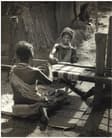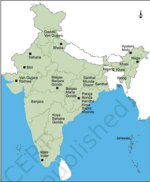Drawing upon the information provided about major tribal groups in India such as Gonds, Santhals, Mundas, Oraons, Banjaras, Khasis, Bhils, Bhutias, and the great Andamanese, which statement accurately captures the essence of the cultural diversity, traditions, languages, and lifestyles that characterize these distinct tribal communities in India?

Important Questions on Tribals, Dikus and the Vision of a Golden Age
Some forests were termed Reserved Forests as they produced timber which the British required. In these forests, people were not allowed to move freely, collect fruits, practise jhum cultivation or hunt animals. The jhum cultivation had therefore to move to other areas in search of work and livelihood.
With reference to the forest laws, which of the given statements is correct?

Which economic activity is being depicted in the image?

Based on the information presented in the image, which Indian state is identified as having the highest concentration of diverse tribal groups, and how does the coexistence of multiple tribal communities in this state impact the region's cultural diversity and heritage preservation?
How did the establishment of colonial rule in India affect the traditional authority and way of life of tribal chiefs, and what were the key changes that occurred in the tribal societies as a result of British rule, including shifts from barter to cash economy, the introduction of commercial agriculture, and land settlement policies?
Elaborate on the intricate process of shifting cultivation, known as jhum cultivation, employed by tribal communities, emphasizing the techniques they used, the significance of forest access, and the reasons why this practice was primarily concentrated in the hilly and forested regions of northeast and central India?
